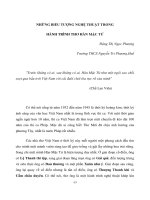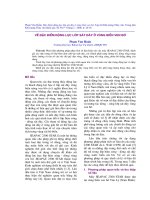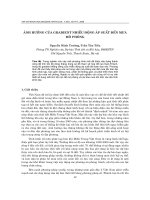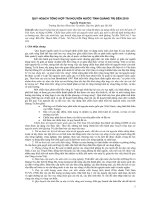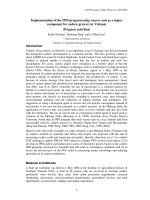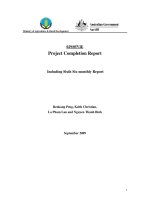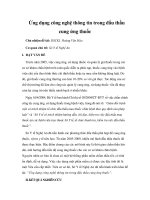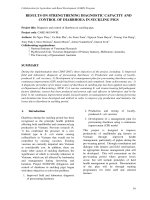Báo cáo nghiên cứu khoa học " INTEGRATED PEST MANAGEMENT USING WEAVER ANTS AS A MAJOR COMPONENT FOR CASHEW " doc
Bạn đang xem bản rút gọn của tài liệu. Xem và tải ngay bản đầy đủ của tài liệu tại đây (7.35 MB, 10 trang )
Collaboration for Agriculture and Rural Development
(CARD)
Program
176
I
NTEGRATED
P
EST
M
ANAGEMENT
USING WEAVER ANTS
AS A
MAJOR COMPONENT FOR CASHEW
Project title:
Implementation of the IPM program using weaver ants as a m
ajor component for
cashew growers in Vietnam
Project c
ode
:
CARD
029/05/VIE
Author(s):
Prof.
Keith Christian
1
,
Dr.
Renkang Peng
1
,
La Pham Lan
2
and
Nguy
e
n Thanh B
i
nh
2
Project Implementing organisations:
1
Charles Darwin University
, Australia
2
Institute
of Agricultural Science of South Vietnam
SUMMARY
Cashew is a very important crop in Vietnam, and the government has designated cashew
development as a national priority. Productivity of cashew has increased since 2002, but the
extensive use of pesticides h
as caused health problems to farmers, their animals and the
environment. The cashew IPM programs using weaver ants as a key element developed at
Charles Darwin University (CDU) do not involve high toxic insecticides, but result in high
yield and nut qualit
y. This project is to use the CDU cashew IPMs to develop and implement
an integrated cashew improvement (ICI) program that will work under Vietnamese
conditions.
An ICI manual and an ICI photo book that work in Vietnam have been developed at 500 and
3000
copies, respectively, and used in the TOT and FFS training, and the positive comments
on the materials are received. The project has produced 113 competitive TOT trainers, who
have successfully conducted 98 FFSs, resulting in 2,448 knowledgeable farmers.
D
emonstration orchards produced 13% more net profit in the ICI plot than in the farmers’
plot. Over 95% of farmers were pleased with the FFS training contents, methods and the
results of demonstration orchards. The project has produced benefits for small
-
ho
lders and
aspects of capacity building, and improved farm environment, farm health and crop
sustainability. There is a high demand of FFS training by local cashew growers.
Keith Christian, Renkang Peng, La Pham Lan & Nguyen Thanh Binh
177
1.
Introduction
Cashew (
Anacardium
occidentale
) is an
important crop in Vietnam,
and the
government
has designated cashew
development as a national priority.
The area
growing cashew is about 430000 ha located in
Central Highlands, South Central Coast and
South East region.
Cashew is planted mainly in
inverse soils that are low in ferti
lity and with
low precipitation. For years, cashew plants
were considered as a forestry plant so that the
growers did not consider any intensive
techniques such as fertilization or plant
protection (David, 1999). When the decree of
Prime Minister signed in
7 May 1999 on the
development of cashew production was
released, the growing area of this plant for
exports expanded rapidly in Southern Vietnam.
However, the productivity of cashew is low
because of serious damage from insect pests
and inadequate farm ma
nagement. Insect pests
of cashew plants has identified that
lepidopterans and hemipterans are
predominant (An, 2003; Lan et al., 2002).
Generally the use of insecticides is a common
practice by farmers to control insect pests. In
some cases the efficacy of
insecticides was not
proven due to misuse and farmer use of
insecticides as a preventive tool.
To achieve
high yields most growers rely heavily on
insecticides, resulting in increased costs, pest
resistance, environmental pollution and the
reduction of na
tural enemies and pollinators.
The suggestion of using a biological agent as
weaver ant (
Oecophylla smaragdina
) instead
of insecticides is not new but has potential as a
control measure. In the Mekong Delta the
application of weaver ants can control insect
pests in citrus orchards and also give fruit with
few blemishes. The use of weaver ants as a
biological control agent of insect pests is
common in the Mekong Delta (Barzman et al.,
1999). Scientists from Charles Darwin
University
found that an IPM program
that
used weaver ants as a key element had been
successfully used by cashew growers in
Australia, Papua New Guinea and
Mozambique (Peng and Duncan, 1999; Peng,
2000, 2001, 2002; Peng et al., 1999, 2004).
Based on the successful examples on citrus
orchards
in the Mekong Delta (Vietnam) and
on cashew orchards in Australia and Africa,
this project was proposed with the aim of
increasing cashew yield and improving nut
quality. Specific objectives are (1) to conduct
TOT training in cashew IPM for TOT trainers
t
o conduct FFSs in their local region, (2) to
develop an IPM cashew curriculum and a
series of illustrative posters based on the
cashew IPM programs developed in Australia
that will work in Vietnamese conditions and
(3) to assess the effectiveness of the FF
S
model in increasing farmer knowledge and
reducing pesticide use in cashew production.
2.
Research contents and methods
2.1.
Research Contents
A Start up workshop was held on 5 May 2006
at the Institute of Agricultural Science of
Southern Vietnam (IAS).
A total of 38 experts
who are involved in Vietnam cashew
production were invited, they came from plant
protection departments, research institutions,
universities, non
-
government organizations,
agricultural services and rural departments, an
insecticide c
ompany and media corporations.
Organization of Training of Trainees (TOT)
classes: Two TOT courses were organized.
One TOT was held at the sub
-
PPD of Binh
Phuoc province, and the other at the Hung Loc
Agricultural Research Center belonging to IAS
located i
n Dong Nai province. Two TOT
courses have resulted in 60 trainees (30 each),
who are currently IPM trainers in rice and
vegetables in provincial sub
-
PPD. Because
cashew trees are perennial, the period from
flowering to harvesting is more important than
oth
er periods. The TOT courses ran from
flowering to harvest. At each site, one
demonstration cashew orchard was established
to enable trainees to practice. Each
demonstration orchard is 1.2 ha, divided into
two treatments. One treatment was managed
by the or
chard owner with his current farming
practices including insecticide sprays. The
other was managed by the IPM program. The
two TOTs of 1st year have been completed, the
two TOT of the 2nd year are currently running.
A total of 120 cashew IPM trainers will
be
available at the end of the project.
Keith Christian, Renkang Peng, La Pham Lan & Nguyen Thanh Binh
178
Organization of Farmer Field School (FFS)
classes: After finishing the course 60 TOT
trainees will become cashew IPM trainers. The
60 IPM trainers will be divided to 30 groups (2
for each group), and each group will
run one
FFS. Each FFS will take 25 farmers. A total of
30 FFSs will be completed in the 1st year and
a total of 750 cashew smallholders will be
trained in cashew IPM. In the 3rd year, each
group of “old trainees” (2 trainers) will run 2
FFSs, and each grou
p of “new trainees” (2
each) will run one FFSs,
A Base line survey was conducted in the target
provinces of this project Binh Phuoc, Dong
Nai, Binh Duong, Binh Thuan, Ba Ria Vung
Tau, Dak Lak and Dak Nong provinces.
3.
Research results and discussions
3.1
Baseline survey
-
Effectiveness of the
FFS model in increasing farmer
knowledge and reducing pesticide use
in cashew production
The effectiveness of the FFS training on
farmers’ knowledge and farming skills has
been assessed against baseline data. Of 1
97
questionnaires collected from the first year
FFS farmers, over 95% of farmers were happy
with the FFS training contents, with the
training methods, and with the results from
FFS demonstration orchards. More that 80% of
the farmers were sure that weaver
ants could
control the main cashew insect pests and
would improve cashew yield and nut quality.
Over 80% of farmers knew how to use weaver
ants, would use weaver ants, and would tell
their friends and other farmers to use the ants.
Farmers’ knowledge about
insect pests,
diseases and their natural enemies as well as
general farming skills has been significantly
improved (Peng et al., 2009).
Farmers’ knowledge about the general farming
activities has been significantly improved.
Compared to the proportion of
farmers
conducting each of these farming activities
before the FFS training, 35%, 49%, 28%, 31%,
and 18% more farmers conducted weeding,
mulching, irrigation, pruning and fertilizer
application respectively after the FFS training.
Compared to the proporti
on of farmers using
insecticides before the FFS training, 24%
fewer farmers used insecticides after the FFS
training (Table 1 and 2). In addition to this,
over 92% of the farmers showed a full
understanding of the principles and tactics of
conducting each
of the above farming
activities.
Table 1
. Number of people who used
insecticides before and after the FFS training.
Insecticide
spray
Before
FFS
After
FFS
Total
Yes
180
133
313
No
17
64
81
Total
197
197
394
Pearson Chi
-
square statistics
χ
2
= 34.329; P <
0.001; df = 1.
Table 2
. Number of people who used
insecticides and herbicides before and after the
FFS training.
Herbicide
use
Before
FFS
After
FFS
Total
Yes
152
147
299
No
44
49
93
Total
196
196
392
Pearson Chi
-
square statistics
χ
2
= 0.352; P =
0.553; df = 1.
In the baseline survey, farmers, on average,
could only recognise < 1 insect pest species,
and 37% of them could not recognise any
insect pests. After the FFS training, on
average, farmers could recognise 3.3 species.
More tha
n 85% of the farmers could recognise
tea mosquito bugs, branch borers and stem
-
root borers, and over 20% of farmers could
recognise thrips, shoot borers, branch borers,
red caterpillars and mealy bugs, which are the
major insect pests in cashew orchards. I
n our
baseline survey, farmers could only recognise
< 1 disease, and 37% of them could not
recognise any disease. Besides, farmers, on
average, could recognise 2 diseases. After the
FFS, 92% of the farmers could recognise the
most important disease ‘anthra
cnose’. In the
baseline survey, a majority of farmers had no
knowledge of the natural enemies of the pest
species. After the FFS training, farmers could
recognise an average of 2.2 species of natural
enemies, and 100% of the farmers knew
weaver ants very w
ell.
With regard to the reduction of insecticide use,
91% of the farmers used insecticides before the
FFS training, but after the FFS training, only
CARD 029/05 VIE
–
IPM for cashew using weaver ants
179
67% of the farmers used insecticides, resulting
in a 24% reduction (Peng et al., 2009). This
was because i
nsect pest damage was greatly
reduced after using weaver ants in their
orchards. However, with the application of the
ICI program, it would expect that the current
level (67%) of farmers using insecticides will
decrease further when farmers get more and
mo
re experience using weaver ants. Besides
this, 92% of the farmers demonstrated a full
understanding of when and how to use
insecticides in their orchards (Peng et al.,
2009). In contrast, in baseline survey, 80% of
the farmers experienced various kinds of
poison symptoms during or after the
insecticide operations (Peng et al., 2006a).
3.2
TOT training in cashew IPM for TOT
trainers to conduct FFSs in their local
region
A total of 113 TOT trainers have graduated
from our two
-
year TOT training (56 in the
first
year and 57 in the second year (Peng et al.,
2008e), and they are very competent in FFS
training (Peng et al., 2008c). These TOT
trainers have successfully conducted 98 FFSs
in their local regions, resulting in 2,448
farmers having graduated with imp
roved
knowledge and farming skills in relation to the
cashew ICI program (Peng et al., 2009).
Opening a TOT course in Binh Phuoc
TOT
Field work in cashew garden
3.3
Field experiments in the
demonstration orchards
3.3.1
Binh Phuoc or
chard
Based on the monitoring data, the common
insect pests in this orchard were tea mosquito
bugs (
Helopeltis
antonii
), shoot borers
(
Alcidodes
sp.), leaf miners (
Acrocercops
syngramma
), aphids, the apple
-
nut borer
(
Nephopteryx
sp), leaf rollers and branc
h
borer.
During the period of pre
-
flowering flush to nut
development (November to March), the
damage level of cashew flushing shoots,
flowers or young nuts by tea mosquito bugs,
shoot borers, leaf miners, aphids and leaf
rollers was similar between the fa
rmer’s plot
and the IPM plot (P > 0.05; Table 3).
However, the average level of developmental
nuts damaged by the fruit
-
nut borer was lower
in the IPM plot than in the farmer’s plot (P =
0.018; Table 3).
Red tea mosquito bug
(
Helopeltis
antonii
)
Blue shoot borer
(
Alcidodes
sp.)
Leaf miner
(
Acrocercops syngramma)
Leaf rollers
Keith Christian, Renkang Peng, La Pham Lan & Nguyen Thanh Binh
180
Table 3
. The mean % shoots damaged by insect pests in the farmer’s plot and the IPM plot of the
demonstration orchard at Binh Phuoc province, Vietn
am. 2008.
Pest name
Treatment
Mean % shoots
damaged /tree
+
SD
Friedman two
–
way ANOVA
Rank sum
Statistic
Tea mosquito
bugs
Farmer
6.5
+
3.8
14.0
X
r
2
= 0.400; df = 1; P
= 0.527
IPM
6.7
+
3.2
16.0
Shoot borers
Farmer
8.3
+
7.0
14.0
X
r
2
= 0.400; df =
1; P
= 0.527
IPM
7.9
+
5.1
16.0
The leaf miner
Farmer
1.8
+
1.6
15.5
X
r
2
= 0.111; df = 1; P
= 0.739
IPM
1.8
+
1.5
14.5
Aphids
Farmer
11.5
+
11.9
14.5
X
r
2
= 0.111; df = 1; P
= 0.739
IPM
12.4
+
11.8
15.5
The fruit
-
nut
borer*
Farmer
0.11
+
0.69
5
7608.0
U = 29405.0; df = 1;
P = 0.018
IPM
0.01
+
0.15
56395.0
Leaf rollers*
Farmer
0.4
+
1.2
56575.5
U = 28372.5; df = 1;
P = 0.933
IPM
0.7
+
3.4
57427.5
*, Mann
-
Whitney U test is used.
During the cashew dormant or leaf flush period
(April to J
uly), the damage on flushing shoots
by tea mosquito bugs, shoot borers and leaf
miners was significantly lower in the IPM plot
than in the farmer’s plot. However, the average
level of shoots with aphids was more in the
IPM plot than in the farmer’s plot (T
able 4
).
Table 4
. The mean % shoots damaged by insect pests in the farmer’s plot and the IPM plot during the
tree dormancy or leaf flush period at Binh Phuoc province, Vietnam.
Pest name
Treatment
Mean % shoots
damaged /tree
+
SD
Friedman two
–
way ANOVA
Rank sum
Statistic
Tea mosquito
bugs
Farmer
6.5
+
11.2
16.0
X
r
2
= 8.000; df = 1; P
= 0.005
IPM
2.4
+
4.3
8.0
Shoot borers
Farmer
5.0
+
2.0
16.0
X
r
2
= 8.000; df = 1; P
= 0.005
IPM
2.4
+
0.9
8.0
The leaf miner
Farmer
1.2
+
1.0
15.0
X
r
2
= 4.500; d
f = 1; P
= 0.034
IPM
0.5
+
0.3
9.0
Aphids
Farmer
9.0
+
5.9
8.0
X
r
2
= 8.000; df = 1; P
= 0.005
IPM
13.3
+
9.6
16.0
3.3.2
Hung Loc Centre orchard
Based on regular monitoring, the main insect
pests in this orchard are tea mosquito bugs,
leaf rollers
, leaf miners, aphids and branch
borers. The minor pests are shoot borers and
mealy bugs. The mean damage level on
cashew flowers and young nuts by each of
these pests was similar between the farmer’s
plot and the IPM plot (Table 5).
CARD 029/05 VIE
–
IPM for cashew using weaver ants
181
Brown aph
ids
Damage on
shoots
Mealy bug
damage on nuts
Weaver ants farm mealy
bugs
Table 5.
The mean % shoots damaged by insect pests in the farmer’s plot and the IPM plot of the
demonstration orchard at Hong Loc Centre, Dong Nai province,
Vietnam. 2008
Pest name
Treatment
Mean % shoots
damaged /tree
+
SD
Friedman two
–
way ANOVA
Rank sum
Statistic
Tea mosquito
bugs
Farmer
1.25
+
2.64
6
X
r
2
= 3.000; df =
1; P = 0.083
IPM
2.49
+
3.40
9
The shoot borer*
Farmer
0.64
+
1.79
5273.5
U = 27
88.5; df =
1; P = 0.135
IPM
0.26
+
1.06
5166.5
Leaf rollers
Farmer
3.13
+
3.85
7
X
r
2
= 0.333; df =
1; P = 0.564
IPM
3.42
+
3.93
8
The leaf miner
Farmer
2.75
+
3.83
7
X
r
2
= 2.000; df =
1; P = 0.157
IPM
2.65
+
4.49
5
Mealy bugs*
Farmer
0.69
+
2.0
3
4780.5
U = 2295.5; df =
1; P = 0.088
IPM
1.96
+
5.49
5659.5
Aphids
Farmer
0.75
+
2.47
6.5
X
r
2
= 1.000; df =
1; P = 0.317
IPM
1.96
+
4.33
8.5
*, Mann
-
Whitney U test is used.
The average number of nuts per tree were
similar between the farmer’s
plot and the IPM
plot (P = 0.206; Table 6). The nuts were
cleaner and shinier in the IPM plot than in the
farmer’s plot.
In the crop season 2008
-
2009, the
demonstration orchard at Hung Loc Centre of
the IAS has also been successfully completed.
The weaver
ant abundance was over 50% from
November 2008 to May 2009, the ant
populations were stable during the period of
cashew flowering and fruiting (January
–
March). Regular monitoring showed that the
main insect pests are tea mosquito bugs, the
shoot borers,
leaf rollers, leaf miners, mealy
bugs and aphids. The mean damage level on
cashew flushing shoots, flowers or young nuts
by shoot borers, leaf rollers and leaf miners
was similar between the farmer’s plot and the
IPM plot. Although tea mosquito damage was
higher in the IPM plot than in farmer’s plot,
the damage caused by tea mosquito bugs was <
5 %, which is lower than the control threshold
determined by Peng et al. (1997). The damage
caused by mealy bugs and aphids was higher
in the IPM plot than in the f
armer’s plot, but
the average damage was <1% and <2% for
mealy bugs and aphids respectively (Table 7).
Table 6.
The number of cashew nuts per half canopy in the farmer’s plot and the IPM plot of the
demonstration orchard at Hung Loc Centre, Dong Nai, Viet
nam. 2008.
Plot (Treatment)
Number of nuts per tree
(No.
+
SD)
Rank sum
Farmer (use insecticides)
179.2
+
104.7
17
IPM (use weaver ants only)
177.9
+
143.9
13
Friedman two
–
way ANOVA
Xr2 = 1.600; df = 1; P = 0.206
Keith Christian, Renkang Peng, La Pham Lan & Nguyen Thanh Binh
182
Table 7
. The mean % shoots damaged by i
nsect pests in the farmer’s plot and the IPM plot of the
demonstration orchard at Hong Loc Centre, February 2008
–
May 2009, Dong Nai province, Vietnam.
Pest name
Treatment
Mean % shoots
damaged /tree
+
SD
Friedman two
–
way ANOVA
Rank sum
Statistic
Tea
mosquito
bugs
Farmer
2.89
+
5.22
19.5
X
r
2
= 4.500; df =
1; P = 0.034
IPM
4.28
+
5.82
25.5
The shoot borer
Farmer
1.51
+
3.84
18.5
X
r
2
= 1.000; df =
1; P = 0.317
IPM
1.95
+
4.72
20.5
Leaf rollers
Farmer
3.25
+
7.19
19.0
X
r
2
= 0.333; df =
1; P = 0.5
64
IPM
4.08
+
7.47
20.0
The leaf miner
Farmer
1.31
+
3.39
22.0
X
r
2
= 1.000; df =
1; P = 0.317
IPM
2.10
+
4.88
23.0
Mealy bugs
Farmer
0.08
+
0.92
17.5
X
r
2
= 4.000; df =
1; P = 0.046
IPM
0.34
+
2.37
21.5
Aphids
Farmer
0.18
+
1.17
17.5
X
r
2
= 13.00
0; df =
1; P < 0.001
IPM
1.75
+
4.36
30.5
The average yield of cashew nuts per tree were
similar between the IPM plot and the farmer’s
plot (Table 8), but the nuts were cleaner and
shinier in the IPM plot than in the farmer’s
plot.
Table 8.
The aver
age yield of cashew nuts per tree in the farmer’s plot and the IPM plot of the
demonstration orchard at Hong Loc Centre, 2009 Dong Nai, Vietnam.
Plot (Treatment)
Yield
(kg /tree
+
SD)
Rank sum
Farmer (use insecticides)
3.8
+
1.4
15.5
IPM (use weaver ants
only)
3.7
+
1.7
14.5
Friedman two
–
way ANOVA
X
r
2
= 0.111; df = 1; P = 0.739
3.3.3
Trang Bom orchard
In Dong Nai demonstration orchard, the third
year experiment (crop season 2008
-
2009) has
been successfully completed. After the ghost
ant was identified
as the major factor to be
responsible for the failure of the main insect
pest control by weaver ants in the first and the
second year (Peng et al. 2008d), to avoid a
strong competition between ghost ants and
weaver ants, existing weaver ants colonies on
t
he orchard boundary were used, together with
the management of boundary trees. This
method was successfully to keep weaver ant
populations high and stable on cashew trees.
The weaver ant abundance was over 60% from
November 2008 to May 2009, and the ant
po
pulations were stable during the period of
cashew flowering and fruiting.
Regular field observations showed that, in
contrary to the results of the previous two
years (Peng et al., 2008d), weaver ants
behaved normally, and they were active to
forage on fl
ushing shoots, flowers and
developing nuts. No competition for food
between weaver ants and ghost ants was
observed. The average number of flushing
shoots and flowers was similar between the
IPM plot and the farmer’s plot.
The main insect pests in this or
chard are tea
mosquito bugs, the shoot borer, leaf rollers,
leaf miners, mealy bugs and aphids (Table 9).
The mean damage level on cashew flowers or
young nuts by each of these pests was similar
between the farmer’s plot and the IPM plot,
with the exceptio
n of aphids that the damage
level was higher in the IPM plot than in the
farmer’s plot. However, the average aphid
damage was < 2% (Table 9).
The average yield of cashew nuts per tree were
higher in the IPM plot than in the farmer’s plot
(Table 10). Also,
the nuts were cleaner and
shinier in the IPM plot than in the farmer’s
plot.
Keith Christian, Renkang Peng, La Pham Lan & Nguyen Thanh Binh
183
Table 9
. The mean % shoots damaged by insect pests in the farmer’s plot and the IPM plot of the
demonstration orchard at Mr Bi’s orchard, 10 November 2008
–
10 April 2009, Dong
Nai province,
Vietnam.
Pest name
Treatment
Mean % shoots
damaged /tree
+
SD
Friedman two
–
way ANOVA
Rank sum
Statistic
Tea mosquito
bugs
Farmer
3.70
+
6.09
18.0
X
r
2
= 3.000; df =
1; P = 0.083
IPM
2.42
+
3.97
15.0
The shoot borer
Farmer
1.37
+
4.07
16.5
X
r
2
= 1.000; df =
1; P = 0.999
IPM
0.89
+
2.63
16.5
Leaf rollers
Farmer
5.35
+
8.40
16.0
X
r
2
= 1.000; df =
1; P = 0.317
IPM
5.12
+
7.82
17.0
The leaf miner
Farmer
1.75
+
4.33
16.5
X
r
2
= 1.000; df =
1; P = 0.999
IPM
1.46
+
3.39
16.5
Mealy
bugs
Farmer
0.01
+
0.15
15.5
X
r
2
= 2.000; df =
1; P = 0.157
IPM
0.09
+
0.55
17.5
Aphids
Farmer
0.07
+
1.00
11.5
X
r
2
= 10.000; df =
1; P = 0.002
IPM
1.68
+
6.30
21.5
Nuts in the IPM plot
Nuts in farmer’s plot
Table 10
. The average y
ield of cashew nuts per tree in the farmer’s plot and the IPM plot of the
demonstration orchard at Mr Bi’s orchard, 2009 Dong Nai, Vietnam.
Plot (Treatment)
Yield /tree (kg)
+
SD
Group t test
Farmer (use insecticides)
13.3
+
2.2
t =
-
2.068; df = 75;
P =
0.042
IPM (use weaver ants only)
14.3
+
2.0
3.4
Development of an IPM cashew
curriculum and an IPM cashew photo book
The cashew curriculum has been developed
based on long
-
term field experiments and field
surveys in major cashew growing prov
inces
(Peng et al., 2008d). It is entitled “The
integrated cashew improvement (ICI) program
using weaver ants as a major component
-
Manual for ICI program trainers and extension
officers in Vietnam”. As planned, the manual
includes up
-
to
-
date information
about cashew
botany, breeding, culture practice, diseases and
their control, insect pests and their damage,
natural enemies, integrated pest control, the
role of weaver ants, weaver ant keeping,
cashew harvest, a checklist of the ICI program
at different g
rowing periods, and four
appendices of guidelines for TOT and FFS
training and for monitoring pest damages and
Keith Christian, Renkang Peng, La Pham Lan & Nguyen Thanh Binh
184
weaver ant abundance (Peng et al., 2008a).
This book was published in 500 copies.
An ICI cashew photo book has also been
developed based on long
-
term field
experiments, field surveys and laboratory
rearing (Peng et al., 2008d). The ICI photo
book covers cashew variety selection,
advanced farming practice, major diseases,
major insect pests, the main natural enemies,
the integrated pest control met
hods, role of
weaver ants, weaver ant keeping techniques,
and the summary of the ICI programme (Peng
et al., 2008b). This book was published in
3000 copies.
4.
Conclusions and recommendation
s
Total of 113 TOT trainers have graduated from
our TOT training,
and they are very competent
in FFS training. These TOT trainers have
successfully conducted 98 FFSs in their local
regions, resulting in a total of 2,448 ICI
program farmers with improved knowledge
and farming skills.
An ICI manual for TOT trainers and
extension
officers in Vietnam and an ICI photo book for
cashew growers in Vietnam has been
developed and used by our TOT trainers in the
FFS training. These manual were published in
500 and 3000 copies, respectively.
After the FFS training, the percentage
of
farmers who used insecticides, reduced to
24%. The current level (67%) of farmers using
insecticides is expected to decrease further
when farmers get more and more experience
using weaver ants. 92% of the farmers
demonstrated a full understanding of whe
n and
how to properly use insecticides in their
orchards.
Over 95% of farmers were happy with the FFS
training programs, with the training methods,
and with the results of demonstration orchards.
There was high demand for the FFS training of
the ICI progr
am by cashew smallholders who
have not been trained because of the positive
impact of the FFS farmers.
Reference
1.
An, Tran Thi Thien
.
2003
.
Preliminary results
of study on the cashew pests in Binh Phuoc
Province. Paper presented at the Workshop on
Plant
protection serving to the policy of
cultivation structure shifting in Central
Highland and Southern Region. Vung Tau,
24
-
25 June 2003.
2.
Barzman, Marco S., Nick J. Mills, and
Nguyen Thi Thu Cuc
.
1999
.
Research on the
effect of the yellow ant (
Oecophylla
sma
ragdina
) on citrus fruit quality.
In
: Van
Mele Paul and Nguyen Van Huynh (Eds)
Proceedings of the 2
nd
symposium on Fruit
production in the Mekong Delta focusing on
integrated pest management
. Vietnamese
–
Belgium IPM in Fruit Production Project.
CanTho, Vi
etnam, 1999.
3.
Davis, Kristin. 1999.
Cashew
. ECHO
Technical Note. http://
www.echonet.org/
.
4.
Lan, L.P., H.X. Quang, V.T.T. Hoan, N.V.
Quoc, N.M. Hung and N.P.D. Huyen. 2002.
Insect pests and diseases of cashew trees,
po
pulations dynamics, and some methods to
contro
l. Final report of the project KN
06.04.NN.
5.
Peng, R.K. 2000.
The control of cashew insect
pests in cashew plantations and small holder
plantings using red ants, Oecophylla
smaragdina
.
-
The first stage of
imple
mentation. A report to the Livestock
Development Corporation, Port Moresby,
Papua New Guinea, August 2000, pp20.
6.
Peng, R.K. and Duncan, I. 1999.
The control
of cashew insect pests in cashew plantations
and small holder plantings using red ants,
Oecophylla
smaragdina
.
-
Preliminary survey
–
Feasibility study of the utilization of red ants
to control the main cashew insect pests. A
report to the Livestock Development
Corporation, Port Moresby, Papua New
Guinea, August 1999, pp46.
7.
Peng, R.K., 2001.
The contro
l of cashew
insect pests in cashew plantations and small
holder plantings using red ants,
Oecophylla
smaragdina
.
–
The second stage of
implementation (Final). A report to the
Livestock Development Corporation, Port
Moresby, Papua New Guinea, March, 2001,
p
p33.
8.
Peng, R.K., 2002. Use of weaver ants, to
control the major cashew insect pests,
Helopeltis
and
Pseudotheraptus
, in the central
Nursery and smallholder orchards in Maganja
Da Costa, Zambezia Province, Mozambique.
A consultant report to ADRA Cashew
Ref
orestation Project, Mozambique,
September, 2002.
9.
Peng, R.K., Christian, K. and Gibb, K. 1997
.
Control threshold analysis for the tea
mosquito bug,
Helopeltis pernicialis
CARD 029/05 VIE
–
IPM for cashew using weaver ants
185
(Hemiptera: Miridae) and preliminary results
of the control efficiency by the green an
t,
Oecophylla smaragdina
(Hymenoptera:
Formicidae) in northern Australia.
International Journal of Pest Management, 43,
233
-
237.
10.
Peng, R.K., Christian, K. and Gibb, K. 1999
.
Utilisation of green ants,
Oecophylla
smaragdina
, to control cashew insect pests.
pp
88,
Rural Industries Research and
Development Corporation, Canberra,
Australia.
11.
Peng, R.K., Christian, K. and Gibb, K. 2004
.
Implementing ant technology in commercial
cashew plantations. RIRDC Publication No.
W04/088, May 2004, ISSN 1440
-
6845.
12.
Peng, R.K
., Christian, K., Bien, P.V. and Lan,
L.P. 2006
a
.
Baseline survey report to CARD.
Charles Darwin University, Australia and
Institute of Agricultural Science for South
Vietnam, Vietnam, 28 August 2006, pp12.
13.
Peng, R.K., Christian, K. and Lan, L.P. 2006
b
.
Fi
rst 6
-
monthly report to CARD. Charles
Darwin University, Australia and Institute of
Agricultural Science for South Vietnam,
Vietnam, 28 August 2006, pp23.
14.
Peng, R.K., Christian, K. and Lan, L.P. 2007
a
.
Second 6
-
monthly report to CARD. Charles
Darwin Univer
sity, Australia and Institute of
Agricultural Science for South Vietnam,
Vietnam, 20 April 2007, pp28.
15.
Peng, R.K., Christian, K. and Lan, L.P. 2007
b
.
Third 6
-
monthly report to CARD. Charles
Darwin University, Australia and Institute of
Agricultural Science
for South Vietnam,
Vietnam, 7 September 2007, pp30.
16.
Peng, R.K., Christian, K., Lan, L.P. and Binh,
N.T. 2008
a
.
Cashew nut ICI curriculum I
“Integrated cashew improvement program
using weaver ants as a major component
-
Manual for ICI program trainers and
extension
officers in Vietnam”. Charles Darwin
University, Australia and Institute of
Agricultural Science for South Vietnam,
Vietnam. October 2008, pp89.
17.
Peng, R.K., Christian, K., Lan, L.P. and Binh,
N.T. 2008
b
.
Cashew nut ICI curriculum II
“Integrated
cashew improvement program
using weaver ants as a major component
–
ICI
Photo Book for cashew growers in Vietnam”.
Charles Darwin University, Australia and
Institute of Agricultural Science for South
Vietnam, Vietnam. October 2008, pp69.
18.
Peng, R.K., Chris
tian, K. and Lan, L.P.
2008
c
.
Competency evaluation report to CARD.
Charles Darwin University, Australia and
Institute of Agricultural Science for South
Vietnam, Vietnam, December 2008, pp11.
19.
Peng, R.K., Christian, K., Lan, L.P. and Binh,
N.T. 2008
d
.
Resea
rch and technical report to
CARD. Charles Darwin University, Australia
and Institute of Agricultural Science for South
Vietnam, Vietnam, 31 July 2008, pp28.
20.
Peng, R.K
., Christian, K. and Lan, L.P.
2008
e
.
Fourth 6
-
monthly report to CARD. Charles
Darwin Univ
ersity, Australia and Institute of
Agricultural Science for South Vietnam,
Vietnam, 28 February 2008, pp22.
21.
Peng, R.K., Christian, K. and Lan, L.P. 2008
f
.
Fifth 6
-
monthly report to CARD. Charles
Darwin University, Australia and Institute of
Agricultural Sc
ience for South Vietnam,
Vietnam, 7 November 2008, pp28.
22.
Peng, R.K., Ch
ristian, K. and Lan, L.P. 2009.
Project validation report to CARD. Charles
Darwin University, Australia and Institute of
Agricultural Science for South Vietnam,
Vietnam, April 2009, pp1
6.
